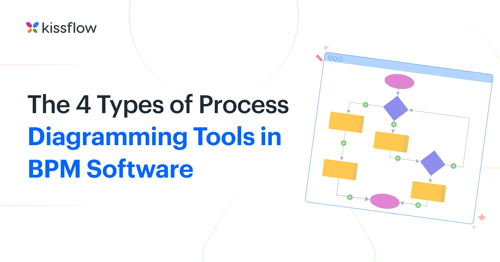The key feature of any business process management (BPM) tool is how it diagrams workflows and processes. The entire idea of BPM is being able to create and edit a process in such a way that a system can follow along.
.webp?width=1200&height=630&name=The%204%20Types%20of%20Process%20Diagramming%20Tools%20in%20BPM%20Software%20(2).webp)
However, diagramming tools have changed a lot in the last several years. Here are the four major types of interfaces you might encounter when selecting a BPM tool.
1. Coding
This was the only option in most of the original BPM software. A programmer would need to go in and manually write out all of the code needed to map out the workflow. He would need to create each task individually, and tell the system what should happen in every situation (if it is approved, rejected, etc).
Coding is still an option for some business process management tools. It provides the highest amount of flexibility because you can build the process completely from scratch. However, only people who know the programming language are able to create and modify the process. Process owners have to rely on the programmer to make the process function properly, and they will need to go back to him frequently for even the smallest changes.
2. Data Entry
At some point, BPM tools began offering an interface that used forms to ask users standard questions about how they wanted the process set up. This was a huge leap because now non-technical users could create their own processes. However, the data-entry model is the least flexible. Users cannot go beyond what is available on the form and are very limited on how they can build workflows.
3. Visual Designer Based on Activities
Many modern BPM options use this designer. It is a good bridge between the business user and the programmer. Most of these options make use of business process model and notation (BPMN). This is a consistent graphical representation to specify a business process. Rather than using a programming language or text fields, the user can actually see graphically what a process looks like.
These designers allow a user to create events and activities as a part of the workflow. Once an activity takes place, the user can then choose what happens. Some activities performed by a machine (like a data transfer) will sequentially and automatically lead to the next activity. At other activities (sometimes called gateways), multiple actions might take place. For example, if it is an approval step, the path will diverge if the answer is yes or no.
These process builders are quite robust in terms of functionality. By the end, you can create something that looks like this:
.webp?width=1200&height=630&name=The%204%20Types%20of%20Process%20Diagramming%20(2).webp)
(Source Wikipedia)
4. Visual Designer Based on Business Steps
Visual design was a huge step for diagramming workflows. However, it was still a compromise between the human business user and the machine. The user needs to learn the proper notation and think through every possibility that might take place after an action is finished.
But most business users don’t think like that. They think in terms of business steps. Step 1, Step 2, Step 3, done.
A visual process modeler that is based on business steps starts from the user’s point of view. It stays in the business context without delving into what the software needs to consider. The user can create a process that shows how the process should function 99% of the time. For example, the above diagram might look like this:
This model makes much more immediate sense for the user. The key difference is that the system takes care of all the additional work that showed up in the earlier notation.
For example, should the CEO reject the notes from the discussion, he can send it back to any earlier step, and the system takes care of it.
Thinking of BPM, but unsure which way to use it? We’ve written about choosing the right BPM methodology here.
Think Like a Human
If you are going to use a BPM software, use the interface that allows your business users to think as they normally do. When they are forced to learn a new notation style just for the sake of creating a workflow, it won’t end up serving their needs.
Kissflow's Process builder is an example of a human-centric workflow that lets business users diagram workflows as they imagine them and then lets the system do all the heavy work in the background. This plays to the strengths of the user and the system. The user knows how the process should run every time and the system can offer the best way to structure the path.
When selecting the best business process management tool, it all starts with the process builder. If you choose one that is complex for your business users, they will either be at the mercy of IT and external consultants for every small change, or they will abandon it altogether. Put the power of making processes in the hands of your business leaders!






.webp?width=1200&height=630&name=The%204%20Types%20of%20Process%20Diagramming%20Tools%20in%20BPM%20Software%20(2).webp)
.webp?width=1200&height=630&name=The%204%20Types%20of%20Process%20Diagramming%20(2).webp)



